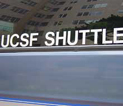Beginning Monday, May 1, UCSF campus shuttles will follow a new routing system designed to improve shuttle frequency and routing between campus sites.
Under the new system, however, all shuttle stops will remain the same.
The primary goal is to better serve the four major campus locations, Parnassus Heights, Mount Zion, Mission Bay and San Francisco General Hospital Medical Center (SFGHMC), in part by reducing the number of stops between these locations.
"About 80 percent of our riders go between these four major campuses," says Jon Gledhill, director of Transportation Services. "We've been asked to focus our attention and resources by serving these four locations in a more expeditious and direct way. We will have a system that's far superior to the one we have now."
One major change in the shuttle routes is the implementation of a color-coded system to help riders determine the fastest way to their destination. See a PDF of the new shuttle route map
here.
In fact, the shuttles will display the direction and color of the transit line on the outside of each vehicle.
Shuttle services will be divided into a series of routing schemes that help minimize travel times between major campus sites and also interconnect less traveled locations with connector service that will allow transfer points with easy and frequent access between all campus sites, Gledhill explains.
Coming and going to the four major UCSF locations is now just a matter of getting on board the blue and gold lines, which run in both directions, clockwise and counterclockwise patterns to Parnassus, Mount Zion, Mission Bay and SFGHMC.
Those working at some UCSF locations will need to transfer to get to their destination. For example, occupants at Laurel Heights can take the tan line to Mount Zion, where they can board a shuttle on the gold line to go to Mission Bay. It's important to note that, despite the need to transfer, shuttle trips will take less time overall, Gledhill points out.
Importantly, the campus shuttle system maintains a direct route (the gray line) connecting the two largest campuses, Parnassus and Mission Bay, during the peak commute times of 6:30 to 9:30 a.m. and 3:30 to 6:30 p.m. As before, these routes use large buses, which are under contract with UCSF.
The shuttles also will continue to link commuters based at Mission Bay to the 16th Street BART station. From Mission Bay, a rider could take the red line to the Mission Center Building, which stops next at the 16th Street BART station. From SFGH, a rider could take the purple line to 2300 Harrison Street and then transfer to the yellow line. However, once the Third Street Light Rail system is up and running sometime around Spring 2008, UCSF will likely stop its shuttle service to the 16th Street BART station, Gledhill says.
"We're a bit overwhelmed with the high demand to link to public transit," he says. "From a resources standpoint, we just afford to provide services that already are available through public transportation. Our main purpose is to more riders between UCSF work sties. The limited transit connection services that we do provide are facilitated due to the lack of nearby public transit services as well as the overall safety of the area served."
Shuttle Service Grows
UCSF has been operating a mini transportation system for decades, starting when the first group of students was driven to student housing at Aldea via a station wagon. The UCSF shuttle program has expanded over the years to transport faculty, staff, students, patients and visitors between primary campus sites and some secondary campus locations for University business throughout the workday. Today, the campus shuttles transport about 2 million passengers a year to destinations across San Francisco.
As the campus has grown in recent years to include a major new campus at Mission Bay and other smaller sites, such as the relatively new site at Minnesota Street, UCSF has responded by adding more shuttles and changing routes to meet growing demand, as necessary.
But the piecemeal modifications to the system can only go so far, Gledhill says, adding that the campus leadership and the shuttle riders themselves have called for more enhancements. The resulting routing system is the product of a thorough analysis of UCSF locations and ridership trends. Changes were vetted through a transportation advisory committee consisting of representatives from a cross-section of the campus community.
UCSF is able to provide free shuttle service to the UCSF community using fees generated at campus parking lots. Also, additional funding comes from fair-share costing assessed to UCSF Medical Center and the campus helps fund some of the new add-on services recently implemented, according to Gledhill.
Asked whether UCSF would ever charge for shuttle service, Gledhill notes that while the issue has been raised and discussed before, the University does not believe it's in the best interests of the campus, which encourages ride-sharing and other transportation alternatives to driving alone. As it is, financing the expanded shuttle service program required additional funding made available through the Chancellor's Executive Budget Committee.
"We're committed to offering a reliable, safe and convenient shuttle service," Gledhill says.
Those with questions about the revamped shuttle service should contact Gledhill at Transportation Services at 415/476-2560 or
email.
Source: Lisa Cisneros
Links:
UCSF Shuttle Bus Services

